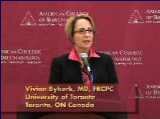"This study highlights the benefits of early DMARD therapy, ideally in combination, using a higher dose of methotrexate," said lead investigator Vivian Bykerk, MD, with the University of Toronto. "However, further investigations are needed to identify those who will and will not benefit from this initial strategy, and those who require a more aggressive treatment strategy."
TEACH prospective data document remission prospects
Dr. Bykerk and colleagues used the Toronto Early Arthritis CoHort (TEACH) of 103 patients with early inflammatory arthritis to determine how many patients reached remission 12 months after the initiation of DMARD therapy. Investigators also compared the different methods of measuring remission currently in use by clinicians.

For more information on this ACR
presentation, watch the press
conference with Dr. Bykerk.
Patients were >16 years old, had symptoms for >6 weeks and <12 months, had either two or more swollen joints, one swollen metacarpophalangeal, or proximal interphalangeal joint; patients also had one of either rheumatoid factor (RF) positive, antibodies to cyclic citrullinated peptide (anti-CCP), morning stiffness >45 minutes, a response to NSAID, or painful metatarsophalangeal (MTP) squeeze test.
They were treated according to formulary guidelines; 59% received initial combination DMARD (methotrexate [MTX] + hydroxychloroquine ± sulfasalazine) therapy and 40% were given MTX monotherapy. In both groups, the MTX dose was 20 mg to 25 mg weekly (sc in 35%). Less than 7% of patients had initiated biologics at baseline; 13% and 28% had initiated biologics at 6 and 12 months.
The 103 patients evaluated were mean age 46 years; 80% female, with baseline symptom duration of 5 months, and 74% initially fulfilled ACR criteria for RA. Thirty-one percent were RF positive, 25% had erosions at baseline, and 52% were anti-CCP positive. The mean baseline HAQ was 0.94 and baseline DAS28 was 5.3.
While some remission criteria are more stringent than others, at the end of the 12-month period approximately half of the patients were able to achieve remission as a result of having started an optimal DMARD therapy.
"Approximately half of the patients seen in an early arthritis cohort were able to achieve remission starting with an optimal and patient appropriate DMARD strategy. The MDA criteria for remission behave similarly to the DAS28 remission criteria. It is more difficult to achieve the SDAI and CDAI remission criteria. Based on these data there is no rationale for reducing the DAS28 remission criteria below 2.6," the researchers concluded.
"An early and accurate arthritis diagnosis is a critical factor that can determine the course of treatment and directly impact the effectiveness of that treatment," said Patience White, MD, chief public health officer of the Arthritis Foundation. "This study reinforces the Arthritis Foundation's commitment to educating the public and general practitioners about the early warning signs of arthritis. Anyone experiencing stiffness in joints or joint pain that persists for 4 to 6 weeks should talk to a doctor about these symptoms immediately."
Remission in Inflammatory Arthritis Patients With Early, Aggressive DMARD Treatment
| Remission Criteria | Proportion in Remission |
||
| Baseline (n = 103) (%) |
6 Months (n = 73) (%) |
12 Months (n = 53) (%) |
|
|
DAS28 ESR (<2.6) |
5.3 | 23 | 31 |
| DAS28 CRP (<2.4) | 4.6 | 38 | 49 |
| SDAI (<3.3) | 1 | 13 | 13 |
| CDAI (<2.8) | 1.1 | 17 | 23 |
| MDA (5/7 criteria) | 3.9 | 36 | 55 |
Reference
1. Bykerk V, Jamal S, Kitamura C, et al. High proportion of remission can be achieved using initial early optimal DMARD therapy in patients with new onset inflammatory arthritis. Presented at: American College of Rheumatology Meeting; November 7-11, 2007; Boston, Mass. Abstract 293.






